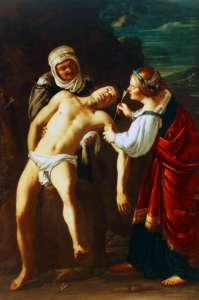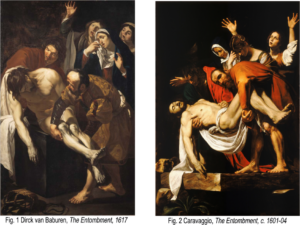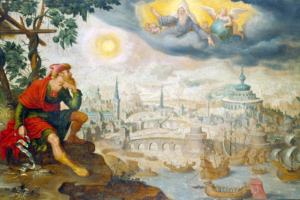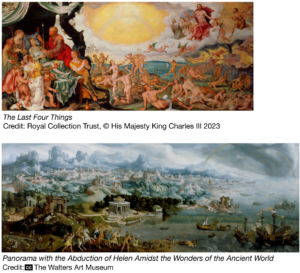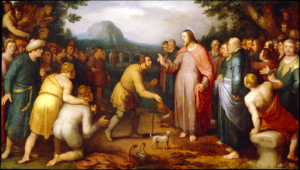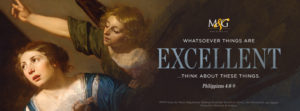In this lovely Annunciation Dutch Golden Age artist, Pieter Fransz. de Grebber, follows the standard imagery–except for two details.
Tag Archives: Dutch art
St. Sebastian Aided by St. Irene
Oil on canvas
Dirck van Baburen (attr. to)
Dutch, c. 1594–d. 1624
In 1581 several provinces in the Netherlands joined in signing The Act of Abjuration, a declaration of independence freeing them from allegiance to Philip II of Spain. With this abjuration these self-governing territories became known as the United Provinces of the Netherlands or simply the Dutch Republic. In Baroque Painting: Two Centuries of Baroque Masterpieces Stefano Zuffi notes that by the early 1600s this Republic “enjoyed a private prosperity and social harmony that was unique.” Precise indicators of this prosperity included documentation noting a healthy daily consumption of calories, high literacy rates, and peaceful co-existence among a diverse religious population. Equally interesting is the fact that these provinces also had “the highest ratio in Europe of works of art, particularly paintings, to number of inhabitants” (Zuffi, p. 154). This cultural backdrop produces a stunning array of artistic talent—Rembrandt, Vermeer, Frans Hals, Heemskerck, Honthorst, Terbrugghen, and the subject of this article Dirck van Baburen.
Although we know that Baburen was born in Utrecht in the late sixteenth century, pinpointing the precise year of his birth is not easily done. For example, in a 2007 monograph on the artist noted scholar Leonard Slatkes puts the date circa 1595. However, art historian Wayne Franits argues for an earlier date, circa 1592. According to Franits this date makes more sense because it places the painter “at an appropriate age for completing his training. . .and traveling to Rome.” Regardless, both scholars agree that the young Dirck began his career under the tutelage of Paulus Moreelse. Moreelse was a distinguished portrait painter who along with Abraham Bloemaert founded Utrecht’s “St. Lucas-gilde.”
After completing his training in 1612 Baburen set out for Italy. He soon settled in the “Eternal City” of Rome. There he came under the spell of the Caravaggisti—stylistic followers of the famed Michelangelo Caravaggio (1571-1610). Caravaggio was one of the most original and influential painters of the 17th century. What set him apart was the dramatic illumination of his canvases which he created by using dark tonalities punctuated with bright shafts of light. This technique called tenebrism is derived from the Italian word, tenebroso, meaning dark or gloomy. Figures 1 and 2 not only illustrate Caravaggio’s innovative technique but also point to the impact of this technique on followers like Baburen.
In comparing Baburen’s canvas to Caravaggio’s Wayne Franits writes: “The Dutch painter’s famed altarpiece The Entombment (Fig. 1), [was] painted in 1617 as part of a group of canvases . . . to adorn the Pietà Chapel in the church of San Pietro. . . . It is well known that The Entombment testifies to its maker’s knowledge of . . . Caravaggio’s famous painting of the same subject (fig. 2), which hung at that time in the Vittrice Chapel in Santa Maria in Vallicella. Van Baburen’s exposure to Caravaggio’s work must have impressed upon him the fact that strongly illuminated figures set against a dark background literally stand out forcefully within a dusky chapel. Van Baburen also deployed the same basic compositional structure as Caravaggio, with its wedgelike arrangement of figures set at a diagonal, cascading downward toward the body of the dead Christ. In van Baburen’s Entombment, however, the stone of the tomb, which, like the Italian’s, also serves as the stone of unction (with its eucharistic implications), is more tablelike while the body of Christ has been rendered in an upright, almost seated position.”
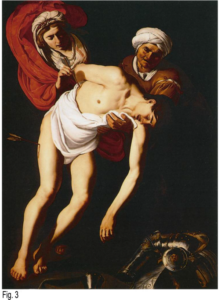 Baburen would return to Utrecht in 1620 where he, along with Gerrit van Honthorst and Hendrick Terbrugghen formed the Utrecht Caravaggisti. Although he died only four years later, his style continued to develop becoming less Italian and more distinctly Dutch. A comparison of M&G’s St. Sebastian Aided by St. Irene to an earlier version he completed while in Rome (Fig. 3) highlights these distinctions especially in the physical appearance of the characters. St. Sebastian was the patron saint of plague victims and a popular subject in religious art throughout the 17th century. The article by Armand P. Gelpi in the Resources section provides a detailed overview of his iconography and connection to the plague.
Baburen would return to Utrecht in 1620 where he, along with Gerrit van Honthorst and Hendrick Terbrugghen formed the Utrecht Caravaggisti. Although he died only four years later, his style continued to develop becoming less Italian and more distinctly Dutch. A comparison of M&G’s St. Sebastian Aided by St. Irene to an earlier version he completed while in Rome (Fig. 3) highlights these distinctions especially in the physical appearance of the characters. St. Sebastian was the patron saint of plague victims and a popular subject in religious art throughout the 17th century. The article by Armand P. Gelpi in the Resources section provides a detailed overview of his iconography and connection to the plague.
Dirck van Baburen died in February 1624; he was buried in the medieval parish church of Buurkerk. His teacher Paulus Moreelse would be laid to rest there 9 years later.
Donnalynn Hess, Director of Education
Resources:
Baroque Painting: Two Centuries of Baroque Masterpieces, Ed. Stefano Zuffi
“Religious Policies in the Seventeenth-Century Dutch Republic,” Jo Spanns
“Dirck van Baburen and the ‘Self-Taught’ Master, Angelo Caroselli,” Wayne Franits
“Saint Sebastian and the Black Death,” Armand P. Gelpi, MD
Saint Sebastian Attended by Saint Irene and Her Maid, Dirck van Baburen (attributed to)
Published 2024
Jonah Under the Gourd Vine
Oil on panel, monogrammed: D.F.
Maerten van Heemskerck (attr. to)
Dutch, 1498–1574
Maerten van Heemskerck was born the son of a farmer June 1498 in the Netherlands. He left the farm to study art under Cornelis Willemsz. in Haarlem and Jan Lucasz. in Delft. Between 1527-1530, Heemskerck placed himself under the tutelage of Jan van Scorel in Haarlem. M&G’s collection includes works by Scorel and Heemskerck’s biographer, Karl van Mander. Scorel had extensively studied in Utrecht (with Jan Gossaert), Germany (with Albrecht Durer), Switzerland, Venice, Jerusalem, Cyprus, Crete, and finally Rome. During his time in Rome, his artistic style was heavily influenced by the works of Michelangelo and Raphael. Scorel brought these new artistic ideas back with him to the Netherlands and taught them to Heemskerck.
Perhaps Scorel’s adventures inspired Heemskerck. Like many today in modern society, Heemskerck planned his own summer vacation. In 1532, he set off for an adventure with the primary purpose of seeing the Seven Wonders of the World. He left a parting gift for colleagues in the form of an altarpiece for St. Luke’s altar in Bavokerk depicting St. Luke painting Mary. He landed in Rome, July 1532. On his travels, he “made accurate, conscientious sketches of antique ruins and statues” (National Gallery of Art). He also was able to view for himself the works of Michelangelo and Raphael. In 1537, he returned to Haarlem where he remained for the rest of his life. He became well known for portraits, religious paintings, and producing designs for engravers.
M&G’s Jonah Under the Gourd Vine displays elements from Heemskerck’s travels. In the background behind Jonah, he includes the Vatican Obelisk as well as a bridge over the Tiber River which he probably saw during his time in Rome. In fact, the city of Nineveh looks more like the city of Rome than a city in the Middle East. Even the figure of Jonah mimics Michelangelo’s figures in The Creation of Adam. The whole composition imitates Heemskerck’s The Last Four Things as well as his Panorama with the Abduction of Helen Amidst the Wonders of the Ancient World.
Heemskerck depicts the portion of the story of Jonah where he has finally obeyed God’s call to preach repentance to the city of Nineveh. In Jonah 1:1, God commissioned Jonah to go to Nineveh and give the city a chance to turn from evil to God. However, Jonah thought that Nineveh deserved condemnation and judgment not mercy (Jonah 4: 2), so he attempted to run in the opposite direction toward Tarshish. Jonah’s disobedience resulted in his spending three days and three nights in the belly of fish before he repented, and God mercifully rescued him. Jonah now had a second chance to obey.
Jonah consented; he went and preached repentance to Nineveh. To his surprise, the whole city repented, including the king. Instead of rejoicing over those who repented, Jonah pouted in anger. Here Heemskerck portrays Jonah taking shelter under the leaves of a gourd vine overlooking the city of Nineveh with God looking down from the heavens. Trailing from his hand is a banner inscribed with BENE IRASCOR EGO VSQVE AD MORTEM IONA CA 4 16 which communicates Jonah’s true feelings: “Rightly I myself am exceedingly angry unto death, Jonah 4:16.” Having experienced God’s mercy first-hand and himself been given a second chance, Jonah should have delighted in God’s compassion. Sadly, he placed himself in the position of telling God what he believed God should have done—to pass judgment on the Ninevites. James 1:19-20 reminds us that unlike Jonah, we should follow God’s example and be “slow to wrath.”
Rebekah Cobb
M&G Collections Support Staff
Published 2023
